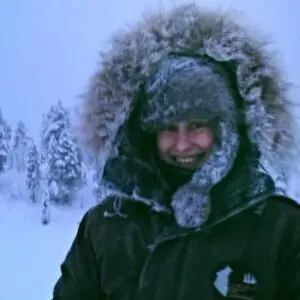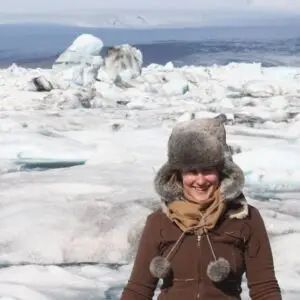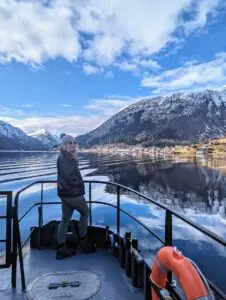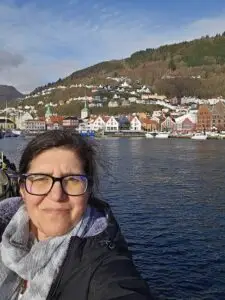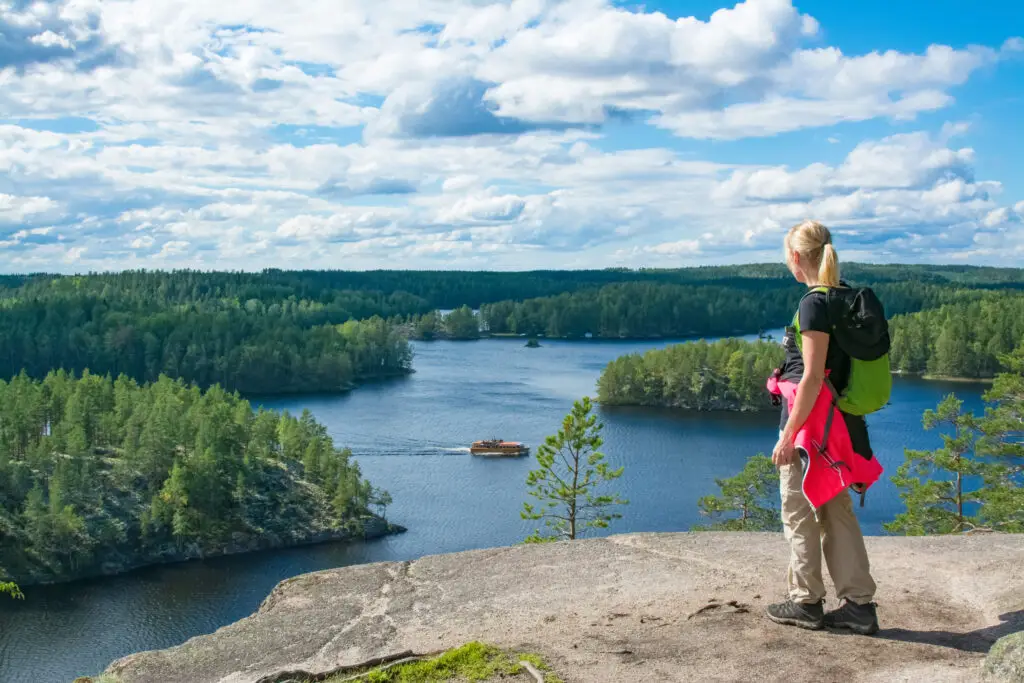Our grand 28-day driver-guided itinerary through Denmark features seven carefully chosen base locations to enable you to explore the country’s royal roots, Viking past, and breathtaking landscapes at a relaxed and luxurious pace.
From Copenhagen to the white cliffs of Møn, the fairy-tale ambiance of Funen, the wind-swept beaches of Fanø, and the wild northern dunes near Skagen, this route highlights both iconic sights and lesser-known treasures. Each day includes three handpicked private touring experiences guided by local experts and supported by your driver throughout.
This is Denmark, uncovered—off the beaten path, comfortably curated, and rich in storytelling.
Destinations on Our 28-Day Denmark Tour
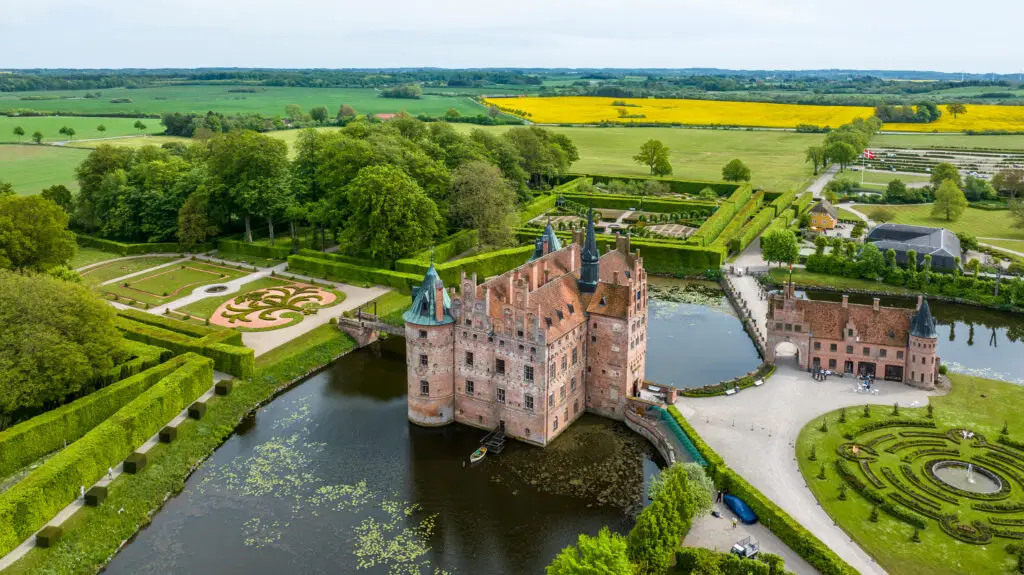
Days 1–5: Copenhagen
Royal palaces, design districts, canals, museums, and North Zealand castles
Days 6–9: Møn & South Zealand
UNESCO cliffs, medieval fresco churches, quiet coastal villages, and castle gardens
Days 10–13: Funen (Faaborg & Svendborg)
Egeskov Castle, Odense’s H.C. Andersen heritage, artisan studios, and manor estates
Days 14–16: Ærø Island
Charming harbors, maritime museums, cobblestone towns, and coastal countryside
Days 17–20: West Jutland (Ribe & Fanø)
Denmark’s oldest town, Viking heritage, seal safaris, WWII bunkers, and Wadden Sea ecology
Days 21–24: East Jutland (Aarhus Region)
Aarhus’ modern art and Viking museums, Djursland’s castles and cliffs, and Silkeborg’s lakes
Days 25–28: North Jutland (Aalborg to Skagen)
Utzon Center, Grenen’s sandbar, migrating dunes, amber museums, and lighthouse hikes
Day 1 – Arrival and Royal Icons of Central Copenhagen
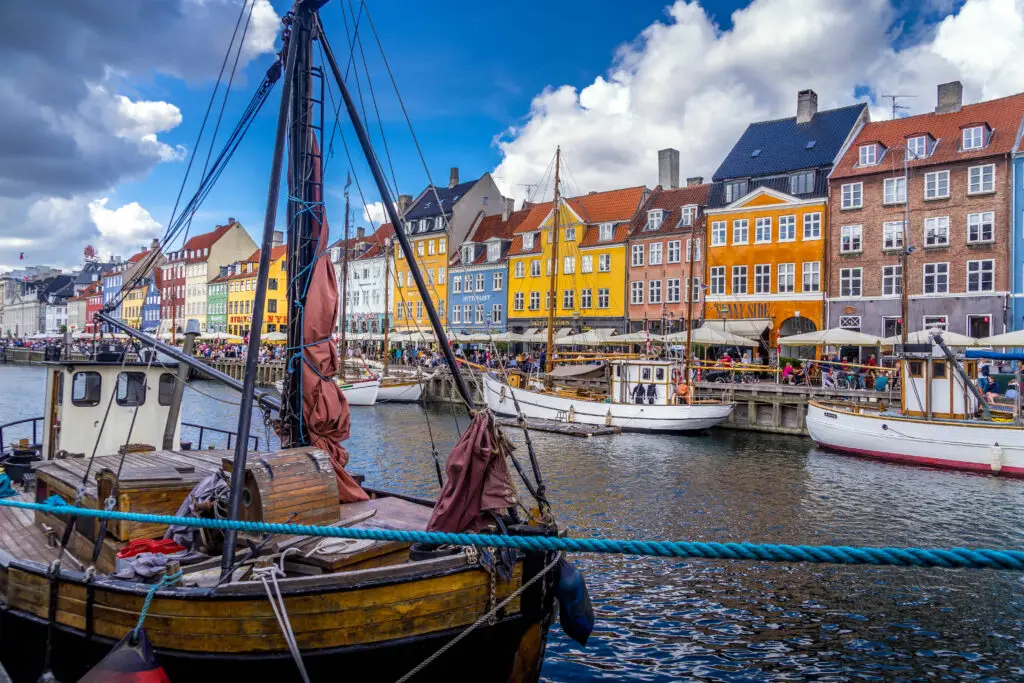
Begin your Danish journey with a private welcome from your driver-guide at Copenhagen Airport.
After settling in, head out for an introductory walking tour of the capital’s most iconic royal landmarks. Stroll along the waterfront at Nyhavn, where historic sailing ships bob in the canal and brightly painted 17th-century houses line the promenade.
Cross into the elegant square of Amalienborg Palace to watch the Changing of the Guard while your guide shares insight into the Danish royal family and palace architecture. Nearby, pause at the Marble Church, whose vast green dome rises above the surrounding mansions.
Later, step inside the regal interiors of Rosenborg Castle. This Renaissance-era stronghold was once the royal residence of King Christian IV and now houses the Danish Crown Jewels.
Every corridor brings new surprises as you turn into lavish halls filled with period furnishings, royal portraits, and shimmering treasures tucked deep within the castle vaults.
Day 2 – Artistic Heritage and Cultural Copenhagen
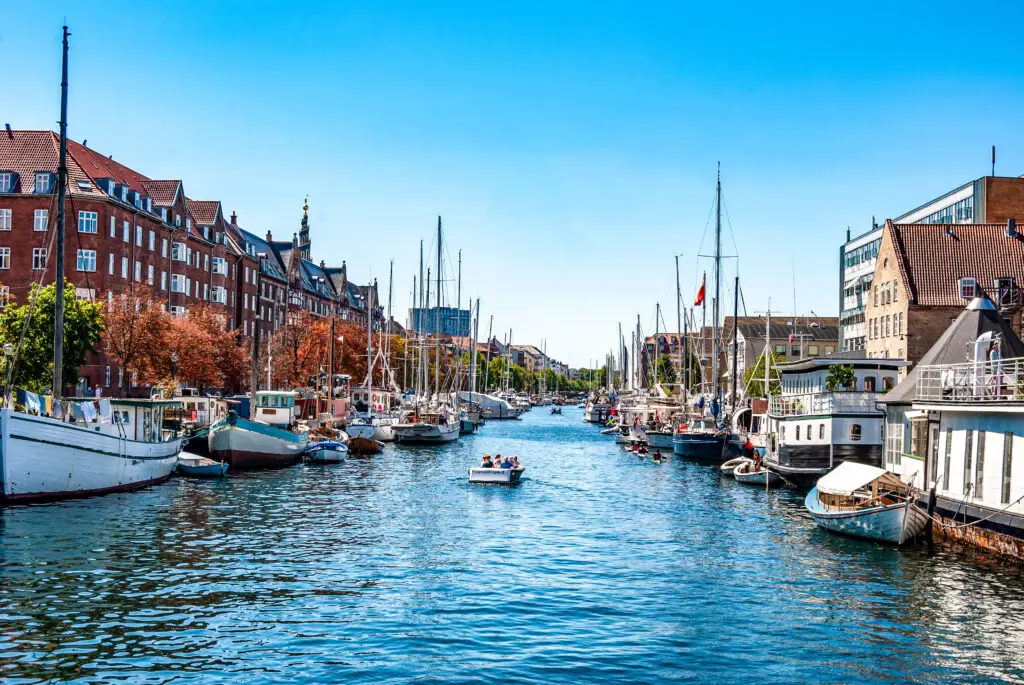
On the morning of day 2, your driver will be waiting to collect you after breakfast, and you will proceed directly to the National Gallery of Denmark (SMK).
Inside, your private guide will take you through a curated journey of Danish and European masterpieces, highlighting works from the Danish Golden Age to modernist icons.
After an enjoyable lunch, your next destination is in the district of Christianshavn, a man-made island once intended for shipbuilders and traders.
Your walking tour reveals the neighborhood’s fascinating evolution from a working-class dock area to Copenhagen’s most bohemian enclave. Wind past canals, colorful houseboats, and 18th-century warehouses repurposed into studios and cafés. If you wish, climb the spiral tower of the Church of Our Saviour for sweeping views across the city and harbor.
The day concludes with a walking tour through the Latin Quarter. Your guide will introduce hidden courtyards, university landmarks, and bookstores that define the area’s intellectual charm.
Cap it off with a climb up the Round Tower—Europe’s oldest functioning observatory—where you’ll walk its wide, spiraling ramp to reach a viewing platform offering 360-degree views over Copenhagen’s spires and rooftops.
Day 3 – Danish Design and Urban Innovation in Copenhagen
Explore the legacy of Danish design at the Designmuseum Danmark.
Gain a true insight into Denmark’s creative spirit as you are guided through rooms filled with mid-century furniture, sleek industrial objects, and experimental design projects.
Discover how Denmark’s commitment to aesthetics and functionality has revolutionized global style through an examination of pieces by Arne Jacobsen, Poul Henningsen, and contemporary visionaries whose influence extends far beyond Scandinavia.
Then, travel to the city’s southern edge to explore Ørestad—a living showcase of modern Danish architecture, where your guide will introduce you to award-winning buildings, such as the 8 House and Mountain Dwellings, designed by Bjarke Ingels Group.
This is Copenhagen’s newest urban district, where architecture meets sustainability, and futuristic design frames everyday life.
In the late afternoon, enjoy a more intimate perspective on Danish creativity with a visit to a local design studio or artisan workshop.
Depending on your interests, you might meet a ceramicist, furniture maker, or textile designer, gaining insight into the craft behind Denmark’s contemporary design movement.
Day 4 – Royal Splendor and Artistic Seascapes in North Zealand
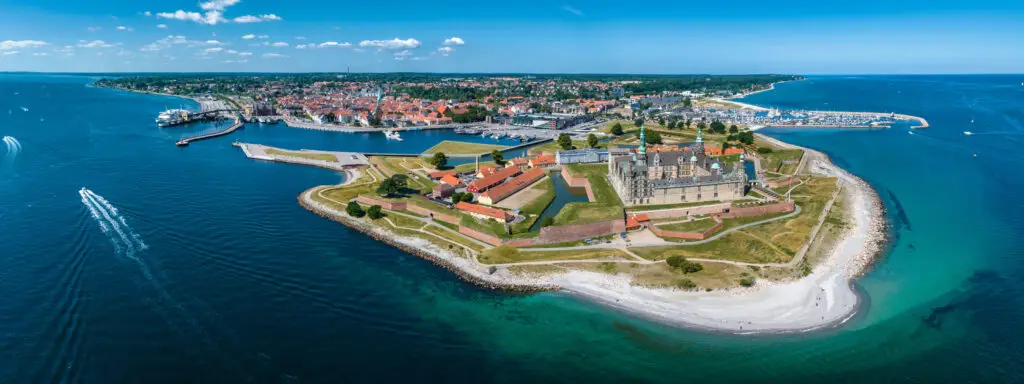
Today’s journey takes you north to the palatial treasures and coastal charm of North Zealand.
Step into your executive class vehicle as your driver sets off for Frederiksborg Castle in Hillerød, the largest Renaissance castle in Scandinavia.
Our team will arrange your private tour tickets to ensure you get the most out of the historic and opulent galleries, filled with portraits, weaponry, and royal tapestries, all curated by the Danish Museum of National History.
Outside, stroll through manicured baroque gardens and cross ornamental bridges that reflect the grandeur of centuries past.
Continue east to Helsingør to tour Kronborg Castle, a UNESCO-listed stronghold immortalized as Elsinore in Shakespeare’s Hamlet.
Explore the gloomy casemates, grand halls, and seaside ramparts with your guide, who will intertwine historical fact with literary legend. The castle’s strategic position at the Øresund Strait offers commanding views across Sweden and an appreciation for its historical importance as a naval and trade hub.
On the return drive to Copenhagen, you can squeeze in one more cultural stop before retiring to your accommodation, with a visit to the Louisiana Museum of Modern Art, situated on the coastal cliffs of Humlebæk and featuring works by Giacometti, Yayoi Kusama, and Danish modernists.
Day 5 – Parliament, Astronomy, and Naval Heritage of Copenhagen
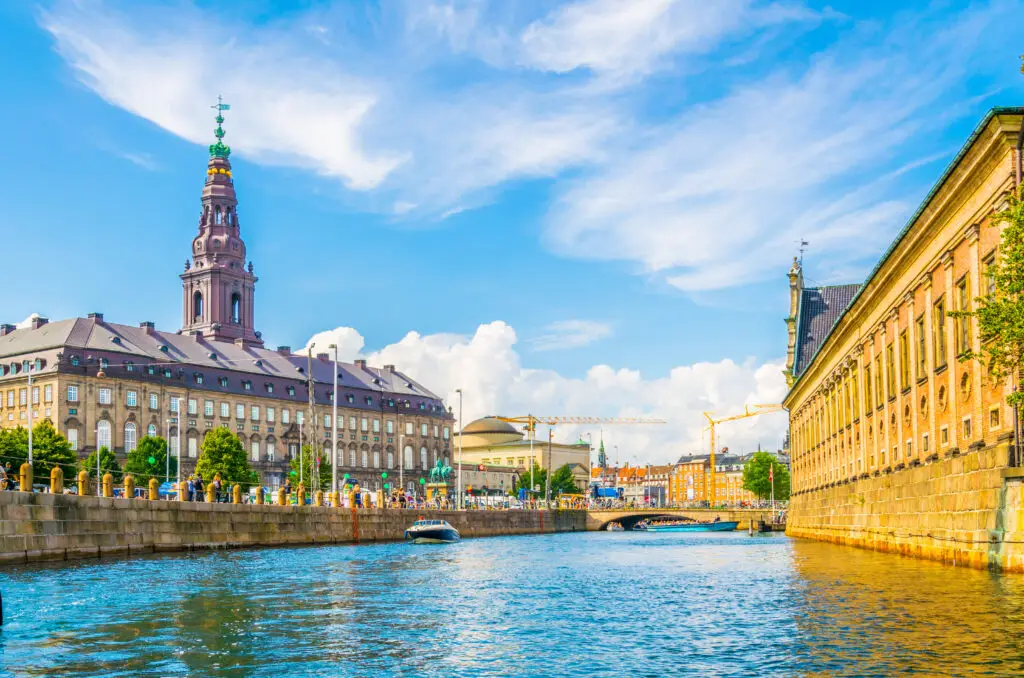
Your final day in the capital gets underway at Christiansborg Palace, home to Denmark’s Parliament, Supreme Court, and royal reception halls. Join your private guide for a tour through the staterooms, where you’ll view ornate ceilings, diplomatic salons, and Queen Margrethe II’s commissioned tapestries that depict Danish history in vivid detail.
Beneath the palace, descend into the ruins of the original 12th-century castle, where layers of stone reveal the foundations of the Danish monarchy.
Afterward, explore the Latin Quarter on foot, where you’ll discover why the area enjoys a reputation as a hub of education and philosophy, home as it is to the University of Copenhagen and some of the city’s oldest public institutions.
As you walk together, you will hear fascinating stories of scholars, revolutionaries, and artists who lived and studied here. Stop by charming bookstores, old churches, and hidden passageways that give the quarter its unique character.
As evening begins to set in, cross over to Holmen and Refshaleøen, former naval shipyards now transformed into creative spaces.
Visit the Royal Danish Naval Museum and explore dry docks, barracks, and industrial buildings that once launched Denmark’s most important fleets. Your guide will narrate stories of exploration and conflict while pointing out how these once-forgotten shipyards have evolved into one of Copenhagen’s most vibrant cultural quarters.
Day 6 – Coastal Cliffs and Cold War History in Stevns and Møn
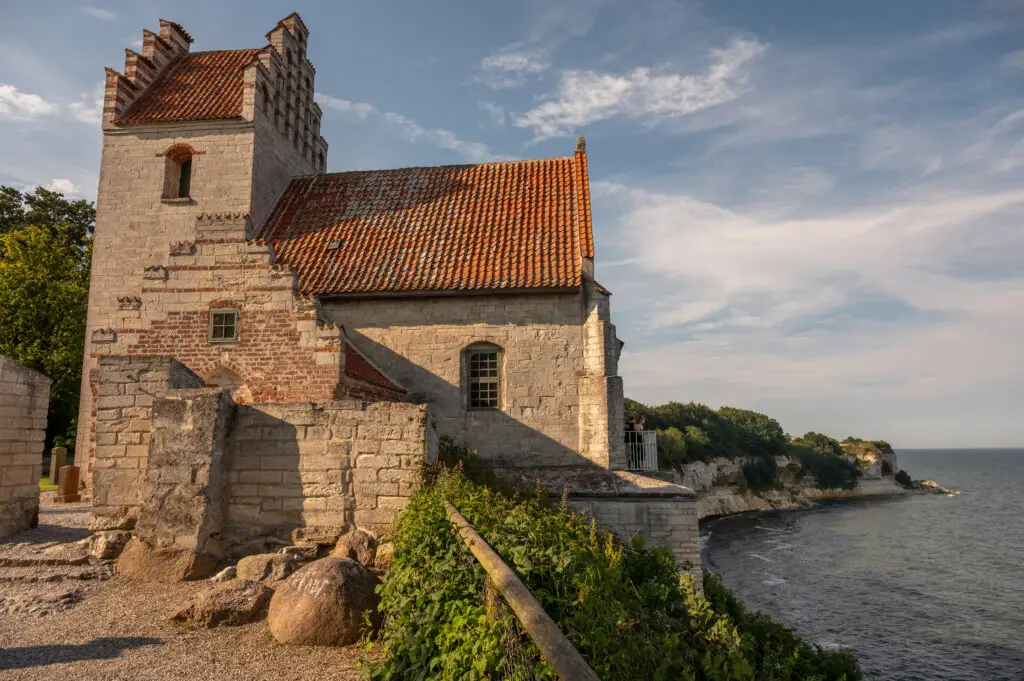
Depart Copenhagen with your driver-guide and head south toward the storied chalk cliffs of Stevns Klint, a UNESCO World Heritage Site.
Begin your visit with a private tour led by a geologist or expert guide, who will interpret the site’s dramatic geological layers and fossil-rich cliffs, providing evidence of the asteroid that ended the age of the dinosaurs. Explore the Cold War Museum Stevnsfort, a decommissioned underground fortress hidden within the cliffs, where tunnels and war rooms reveal Denmark’s role during the Cold War.
Afterward, stop at the clifftop Højerup Church, which teeters dramatically above the sea. This medieval chapel, which partially collapsed into the sea in 1928, offers insight into centuries of coastal erosion and the ever-changing landscape of southern Denmark.
Explore the chapel ruins and take in the sweeping sea views from this peaceful and poignant spot.
Arrive on the island of Møn in the late afternoon and settle into your countryside accommodation.
If time and weather permit, your guide will take you on a short cliffside walk near Møns Klint GeoCenter to enjoy the evening light and your first glimpse of the island’s spectacular landscape.
Day 7 – Natural Wonders and Garden Escapes of Møn
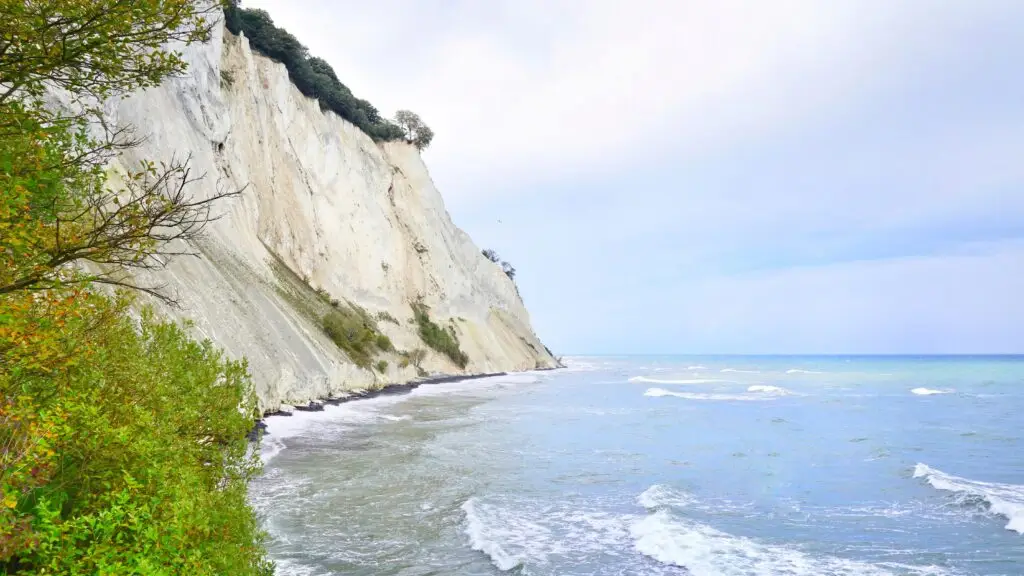
This morning, enjoy a guided hike through the majestic cliffs and forest trails of Møns Klint.
As you trek along panoramic viewpoints and secluded pathways while explaining the geology, flora, and unique biodiversity of the area. You’ll have opportunities to examine fossils, understand the impact of glacial movement, and appreciate the silence of this remote coastal wonder.
Next, visit Liselund Castle, a hidden gem tucked into a romantic English-style garden just a short drive from the cliffs.
This thatched-roof manor was built as a summer retreat in the 18th century and is surrounded by sculpted lawns, bridges, and artificial ruins designed to delight and surprise.
Next, explore Elmelunde Church, one of Denmark’s oldest churches, renowned for its medieval frescoes. Your guide will point out scenes from daily life and biblical stories captured in the colorful 15th-century murals painted by the anonymous “Elmelunde Master.”
Day 8 – South Zealand Castles, Ceramics, and Coastal Culture
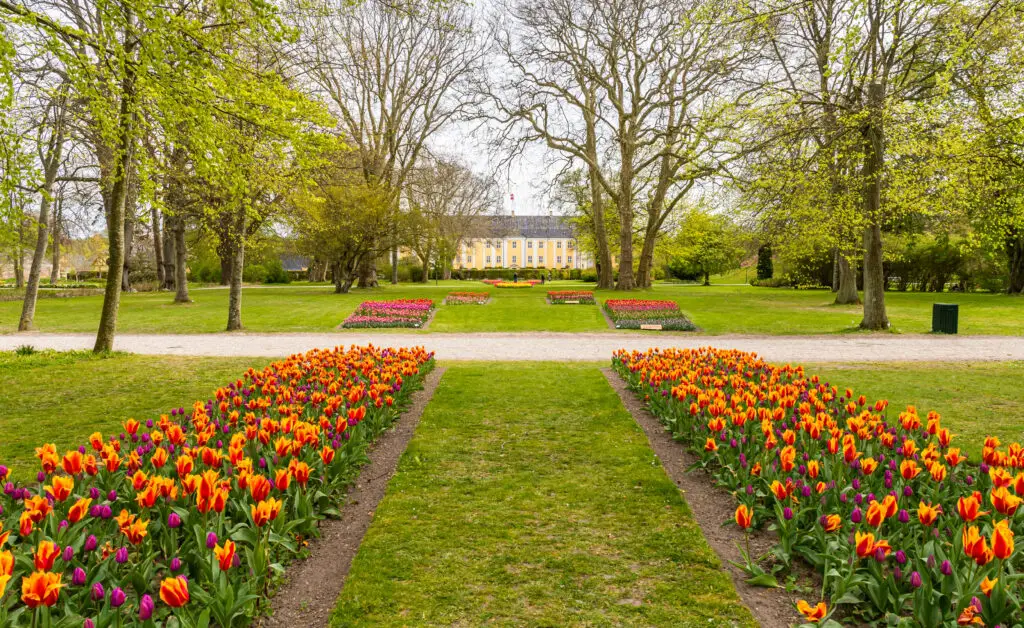
Our first destination on day 8 is Gavnø Castle, a pastel-colored baroque manor surrounded by tulip gardens and romantic parkland.
Inside, admire one of Denmark’s largest private art collections, showcasing works from the 16th century onward. A private tour here is the ideal way to reveal the castle’s fascinating history, including tales of its noble owners and its time as a convent for noblewomen.
Our itinerary now turns to Denmark’s celebrated affinity with ceramics in the nearby town of Næstved. We will curate an experience for you through local galleries and artisan studios, where you can meet potters, sculptors, and designers producing everything from traditional stoneware to sleek, modern pieces. Discover the revival of ceramics in this region and the techniques that have made Danish design globally admired.
Next up is the final private tour of the day, which includes a visit to Holmegaard Glass Factory, one of Denmark’s most historic glassworks.
Take the opportunity to watch expert glassblowers in action. The museum’s exhibitions trace centuries of glass art, showcasing both heritage pieces and contemporary design collaborations. If time allows, consider participating in a brief glass-blowing demonstration before returning to your hotel.
Day 9 – Coastal Walks, Frescoed Churches, and Lighthouse Views in South Zealand
Day 9 marks the end of your stay in South Zealand with a coastal walk around the picturesque harbor town of Karrebæksminde. Explore sandy beaches, colorful fishing cottages, and a working harbor known for its laid-back maritime vibe.
Cross the footbridge to the small island of Enø and enjoy peaceful walking paths, sea views, and local birdlife.
Afterward, visit one of the region’s historic lighthouses for panoramic views of the Baltic Sea.
Depending on time and interest, your guide may take you to the towering lighthouse at Avnø Nature Reserve or a smaller, lesser-known beacon perched above the cliffs. These lonely landmarks offer insight into Denmark’s maritime heritage and provide excellent photography opportunities.
Day 10 – Egeskov Castle, Faaborg’s Historic Streets & the Svanninge Hills

Begin your time on Funen with a private visit to one of Denmark’s most enchanting Renaissance landmarks—Egeskov Castle. With its symmetrical turrets, moat, and sprawling gardens, the castle feels lifted from a fairy tale.
Your guide will lead you through elaborately furnished rooms, displays of knightly armor, and rare collections that range from antique toys to vintage cars. The castle’s treetop walk and hedge maze add an element of playful exploration for all ages.
Next, travel to the coastal town of Faaborg for a private walking tour amongst its pastel-hued merchant houses. Visit the town’s watchtower, a symbol of its medieval heritage, and explore the local galleries nestled within centuries-old buildings. Along the way, your guide will share insights into Funen’s maritime legacy and the development of local artisan guilds.
Before retiring to your accommodation for the night, take one more nature walk through the nearby Svanninge Bakker hills—also called the “Alps of Funen.”
These gently rolling landscapes are ideal for light hiking and panoramic photography.
Day 11 – Odense’s Literary Past, Folk Culture & Artistic Green Spaces
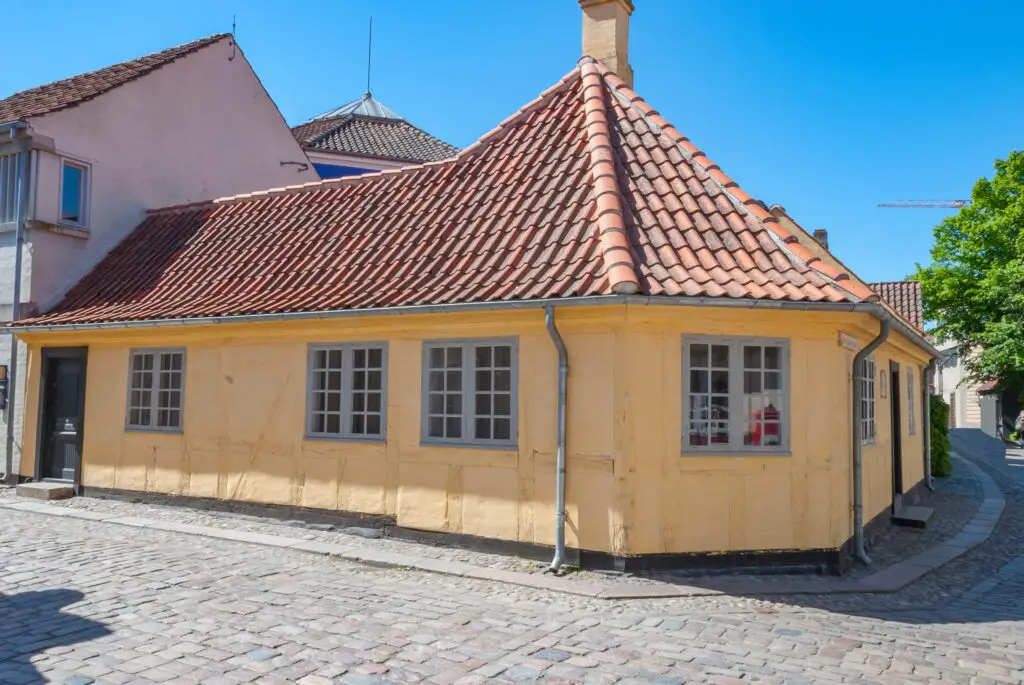
Travel north to Odense, the birthplace of Hans Christian Andersen, for a day dedicated to storytelling and the preservation of folk heritage.
Begin at the H.C. Andersen Museum, where a private guide will trace the life and legacy of Denmark’s most famous writer. Explore immersive exhibits, original manuscripts, and the house where Andersen was born.
From there, step into Denmark’s rural past at the Funen Village open-air museum.
This collection of period farmhouses, mills, and workshops provides a vivid glimpse into 18th- and 19th-century village life. As you wander through cobbled lanes and half-timbered structures, your guide will introduce you to costumed interpreters, traditional farming methods, and the stories behind the preserved interiors and gardens.
End your day with a quiet stroll through one of Odense’s sculpture gardens or artistic green spaces. With your guide, uncover hidden works by contemporary Danish artists or relax by a pond surrounded by public art. This is an opportunity to reflect on how Odense combines literary heritage and contemporary creativity in a distinctly Danish manner.
Day 12 – Troense Harbor, Valdemars Castle & Artisan Craftsmanship
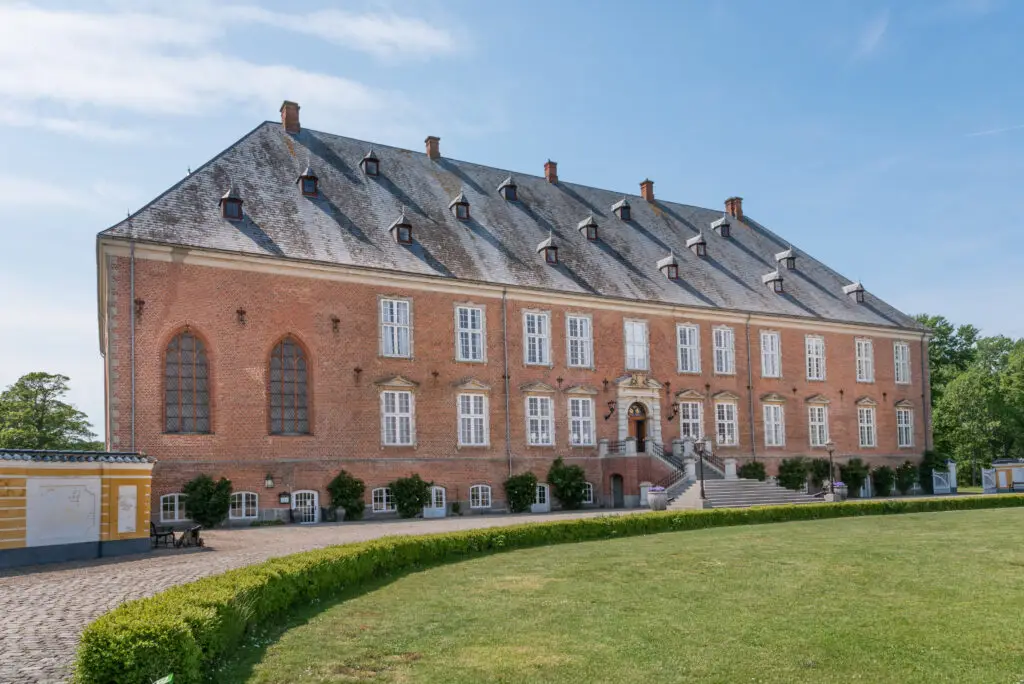
Start your morning in the village of Troense, where charming, thatched-roof houses line winding streets near the harbor.
On a private walking tour, your guide will discuss the area’s shipbuilding history and merchant past, pointing out architectural details and quiet gardens along the way. Troense’s picturesque setting on the Svendborg Sound makes it a favorite among photographers and painters.
Next, visit Valdemars Castle, set on the scenic island of Tåsinge. While the interior of the castle may be viewed from the grounds (depending on the season), your guided tour will focus on the estate’s role in naval history, noble family traditions, and romantic legends—including the story of Elvira Madigan.
Explore the grounds, forest paths, and perhaps the private chapel that overlooks the sea.
As the sun begins to set, meet a local artisan in their workshop—either a woodcarver specializing in traditional Nordic designs or a ceramicist known for their island-inspired glazes.
Learn about their techniques, materials, and creative processes, and have the opportunity to browse or, perhaps, even commission a bespoke piece to return home with you.
This behind-the-scenes visit offers a hands-on connection to Funen’s enduring culture of craftsmanship.
Day 13 – Broholm Manor, Ancient Megaliths & the Coastal Trails of Lundeborg
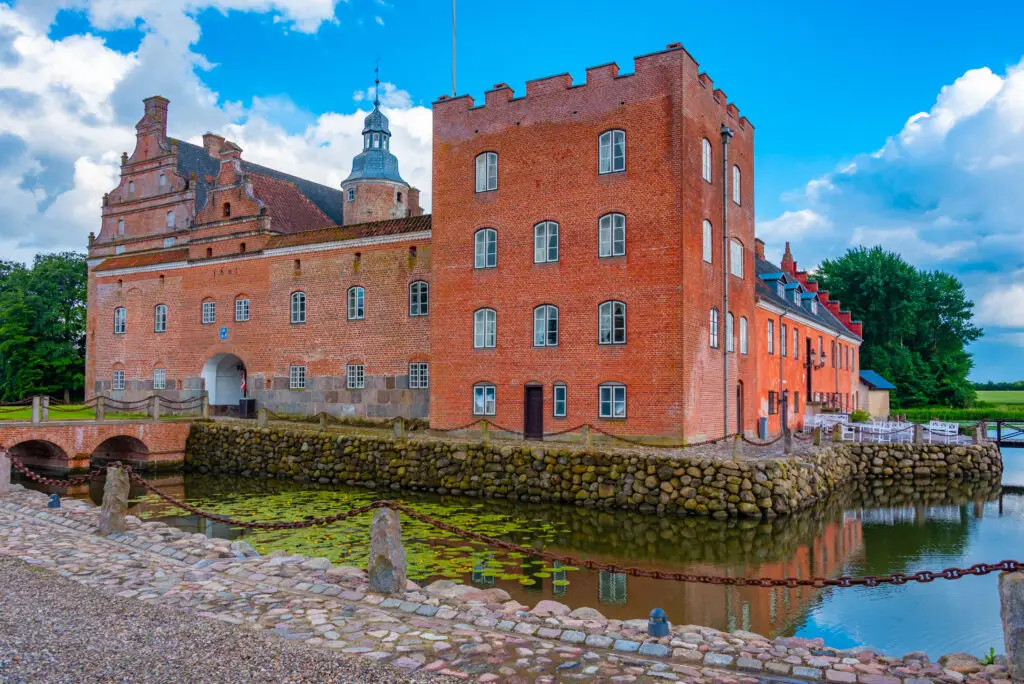
Your day begins with a visit to Broholm Manor, one of Denmark’s most atmospheric historic estates.
After a brisk drive with your driver, step inside to explore the stately home’s salons, libraries, and heirloom-filled rooms that reflect centuries of noble living. The estate also houses a fascinating archaeological collection—spearheaded by a former owner who helped shape Denmark’s early antiquarian movement.
Continue to a nearby collection of megalithic monuments that date back thousands of years.
These ancient burial mounds and standing stones are located in quiet woodlands and open fields. Your guide, trained in Nordic archaeology, will interpret the spiritual and ceremonial significance of these mysterious sites, sharing insights into Denmark’s Neolithic past.
What better way to end the day than with a peaceful beach walk at Lundeborg, a tranquil fishing village along the Great Belt coast. As you stroll along the shoreline, learn about local fishing traditions, seaweed harvesting, and the geological history of this lesser-visited stretch of coast. It’s a gentle and atmospheric close to your final day on Funen before continuing west to the Wadden Sea.
Day 14: Ferry to Ærø | Ærøskøbing Old Town Walk | Windmill & Countryside Drive
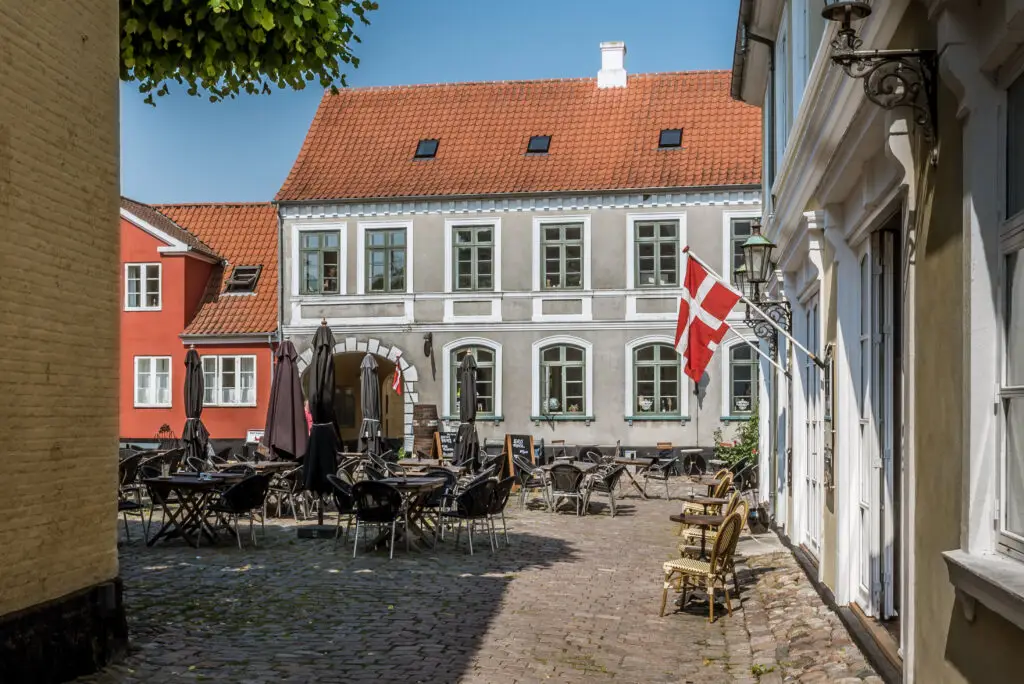
Travel by ferry from Funen to Ærø, one of Denmark’s most picturesque islands.
Upon arrival, take a private guided walking tour through Ærøskøbing, the island’s charming town with its colorful facades and historic merchant houses. Your guide will share tales of sea captains, trade routes, and the island’s golden maritime age.
In the afternoon, set off on a scenic countryside drive with your driver-guide.
Stop at 18th-century windmills, rural churches, and panoramic viewpoints over rolling fields and the Baltic Sea. Hear stories of island traditions and local customs as you explore Ærø’s charming interior villages and farmlands.
Day 15: Marstal Maritime Museum | Seaside Walking Path | Local Historical Farm Visit
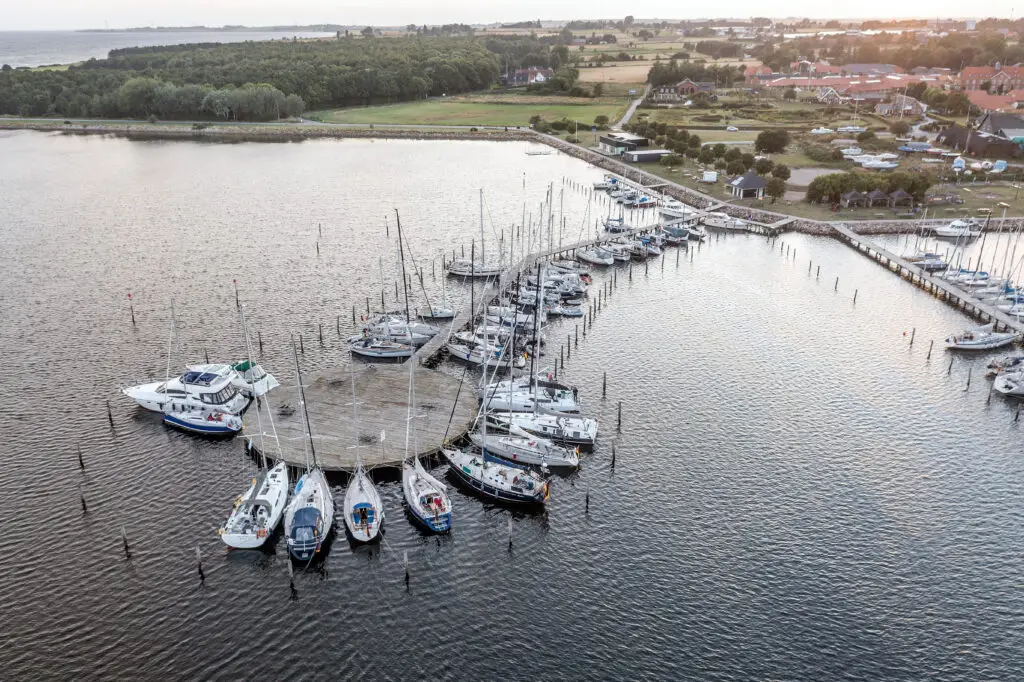
Today gets underway in the seafaring town of Marstal with a private guided visit to the Marstal Maritime Museum.
Learn how this small town once boasted one of Denmark’s largest merchant fleets. Explore intricate ship models, navigation tools, and sailor diaries that offer a vivid picture of life at sea.
Then, take a relaxed guided walk along one of Ærø’s coastal trails, enjoying fresh sea air and views over sheltered coves and rocky shorelines. Your guide will introduce the local flora and birdlife while sharing stories of island life past and present.
Later, visit a working historical farm that preserves Ærø’s agricultural heritage. Meet the caretakers, see traditional farming equipment, and discover how these smallholdings have evolved over time to incorporate modern sustainability practices while preserving their historic roots.
Day 16: Søby Hike to Voderup Cliffs | Fishing Hamlet Visit | Return Ferry with Scenic Drive
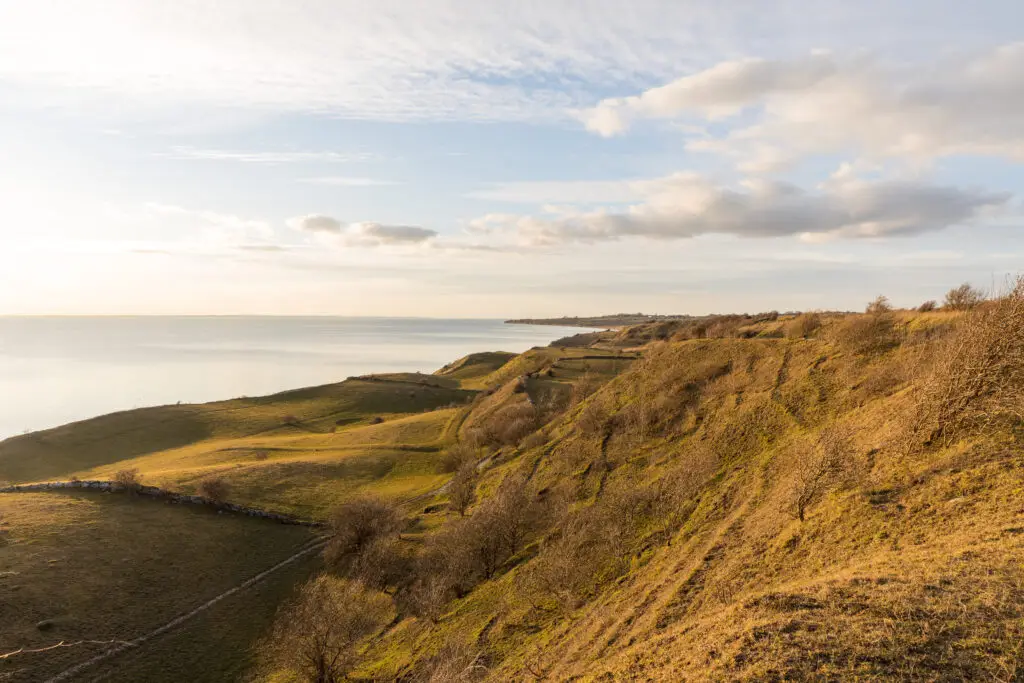
Travel to the northern end of the island to Søby, where your private guide will lead a hike along the clifftop trails of Voderup Klint.
This natural terrace, featuring layered cliffs and grassy slopes, offers sweeping views of the sea and is one of Ærø’s most stunning natural landmarks.
We also recommend a stop in one of the island’s quiet fishing hamlets, where you can take some time out to walk the docks, hear stories from locals, and observe preserved wooden boats that are still in use today.
End your Ærø stay with a scenic drive back to the ferry terminal, taking in final views of coastal meadows and wind-swept beaches. Board the ferry for your return to Funen or onward journey.
Day 17: Drive West | Ribe Medieval Town Tour | Ribe Viking Center Visit
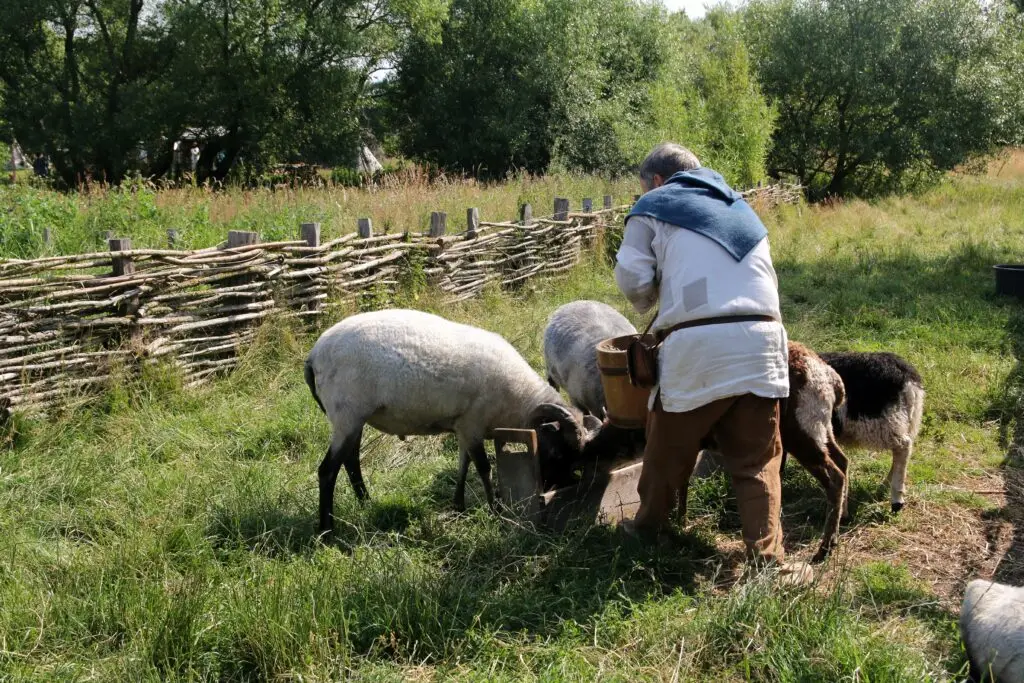
Depart Funen for West Jutland with your private driver-guide, making your way through the countryside toward Denmark’s oldest town.
On arrival in Ribe, take a private walking tour through its cobbled lanes and half-timbered houses. Step inside Ribe Cathedral and hear tales of Viking traders, medieval bishops, and Renaissance merchants that shaped the town’s rich history.
In the afternoon, continue to the Ribe Viking Center, where costumed interpreters bring the 9th and 10th centuries to life. Walk through reconstructed longhouses, watch blacksmiths and weavers at work, and explore hands-on exhibits that explain how archaeology has helped revive the stories of Denmark’s earliest rulers and raiders.
Relax in Ribe’s quiet lanes or along its riverside walkways as you settle into your base for the next few nights.
Day 18: Ferry to Fanø | Nordby Tour | Seal Safari or Beach Carriage Ride
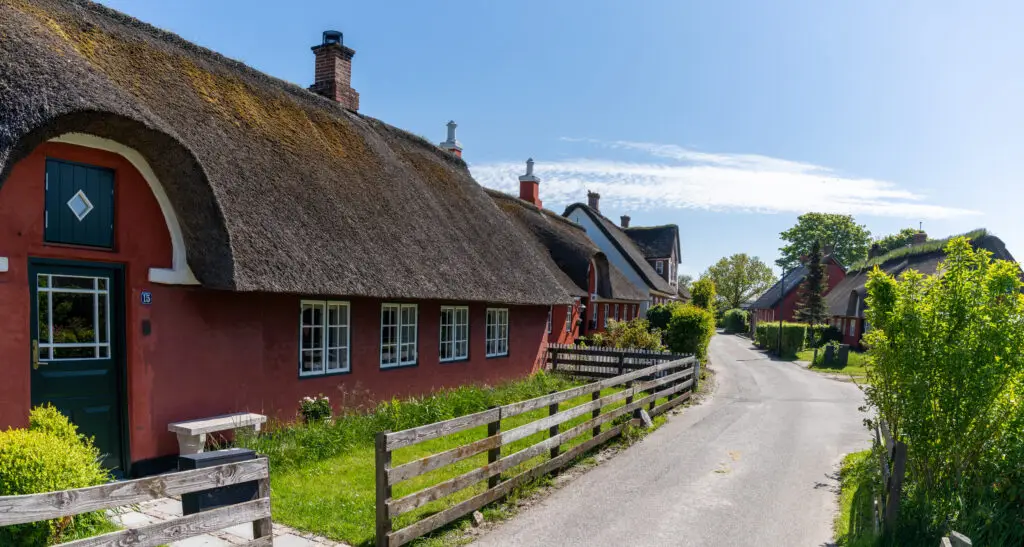
Catch a morning ferry with your guide across to Fanø, one of the Wadden Sea’s most beloved islands. On arrival, enjoy a private walking tour through the harbor town of Nordby, known for its thatched-roof houses, local art galleries, and maritime traditions. Learn how this compact port became a vital hub for Denmark’s sailing fleets and creative communities.
Later, set out for a guided seal safari—either by boat or from a tidal beach viewpoint—depending on the season and weather. Observe harbor seals resting on sandbanks or swimming in coastal shallows while your naturalist guide explains their behavior and role in the marine ecosystem.
If you prefer to stay on land, enjoy a traditional horse-drawn carriage ride along Fanø’s expansive beaches or dune trails, taking in the dramatic landscape and sea breezes in comfort and style.
Day 19: Sønderho Dunes | Fanø Art Museum | WWII Bunker Tour
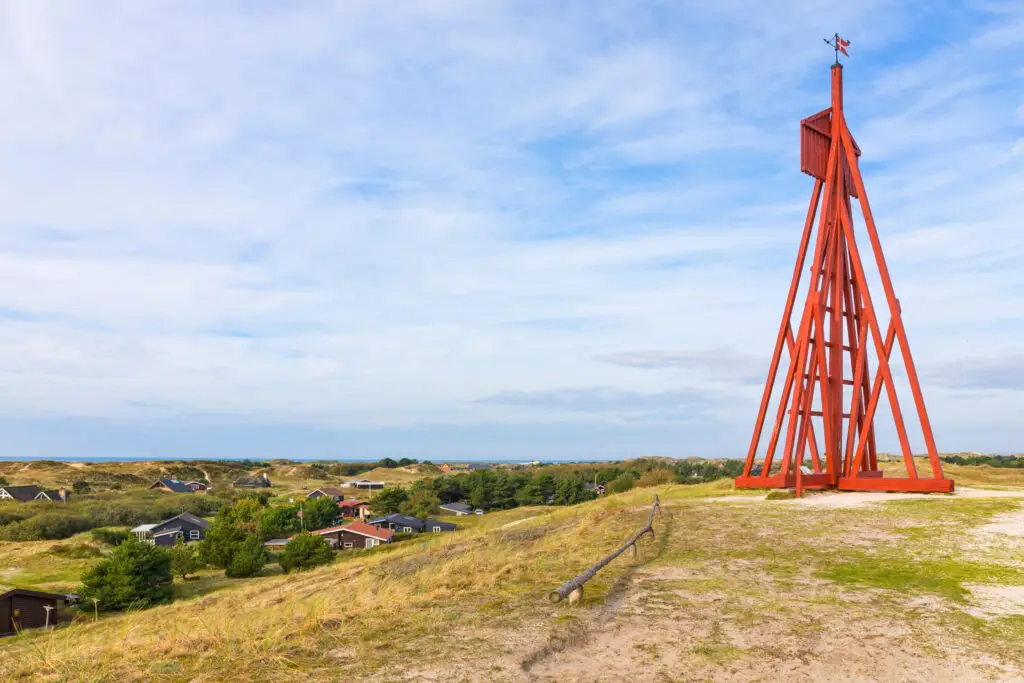
Head to the southern part of Fanø to explore the protected dunes near Sønderho. Take the opportunity to walk through wind-sculpted sands and grassy hills, spotting migratory birds and learning about the ecological significance of this UNESCO-listed landscape.
Sønderho itself is one of Denmark’s most picturesque villages, and your guide will point out its architectural and historical highlights along the way.
Next, enjoy a guided visit to the Fanø Art Museum, a jewel-box collection of island-inspired artwork. Discover the lives and works of Danish painters drawn to Fanø’s shifting light and seascapes, and learn how the island fostered a quiet artistic renaissance in the 19th and 20th centuries.
In the afternoon, delve into Fanø’s wartime past with a private tour of World War II bunkers and coastal defenses. Your historian guide will take you through intact German fortifications nestled in the dunes, sharing personal stories and historical context from the island’s occupied years.
Day 20: Wadden Sea Center | Mudflat Ecology Tour | Sunset Dunes Walk
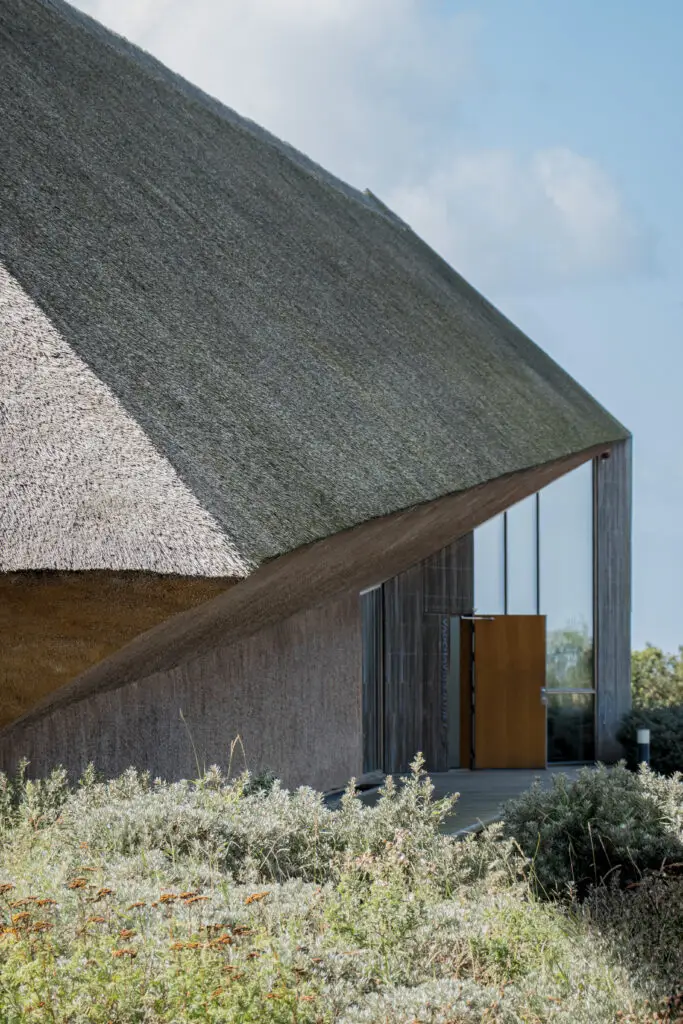
Enjoy a relaxed breakfast at your accommodation before joining your private driver as you set off for the award-winning Wadden Sea Center, one of the world’s most important wetlands for migratory birds and marine life.
Afterward, head out on a guided mudflat walk, tide permitting. Accompanied by a trained naturalist, you’ll trek across the sandy seabed to see tidal creatures, learn about local shellfish species, and understand how the landscape continually reshapes itself. It’s a rare opportunity to walk where the sea normally reigns.
End your day with a peaceful sunset walk through the nearby dunes. With golden light casting long shadows over the tall grasses and creeks, your guide will help you identify native flora and reflect on the delicate balance of land and sea that defines Denmark’s western coast.
Day 21: Drive to Aarhus | ARoS Art Museum | Harborfront Modernism Tour
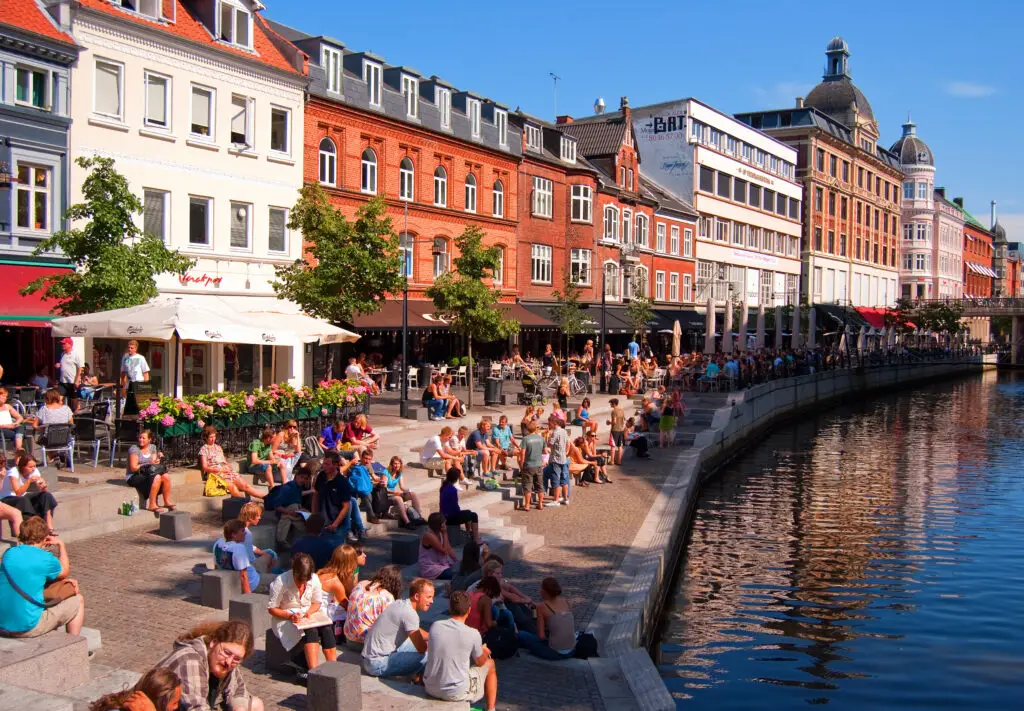
Travel east with your driver-guide from West Jutland toward Denmark’s second-largest city, Aarhus.
Arriving by midday, begin your stay with a guided visit to the ARoS Art Museum, one of Scandinavia’s leading contemporary galleries. Explore thought-provoking exhibitions and installations before ascending to the museum’s rooftop to experience Olafur Eliasson’s iconic “Your Rainbow Panorama”—a circular, colored-glass walkway offering views over the cityscape.
Later, take a private walking tour of Aarhus’s revitalized harborfront. Once an industrial zone, the district now features sleek modernist buildings, public art, and green waterfront design. Your guide will highlight landmarks such as Dokk1 (the public library and cultural center), the Iceberg residences, and the new harbor bath, discussing how Aarhus balances innovation with sustainability.
Conclude the day with time to settle into your hotel and enjoy the city’s vibrant but relaxed atmosphere, with cafés and architecture that invite lingering.
Day 22: Den Gamle By | Moesgaard Viking Museum | Deer Park Walk
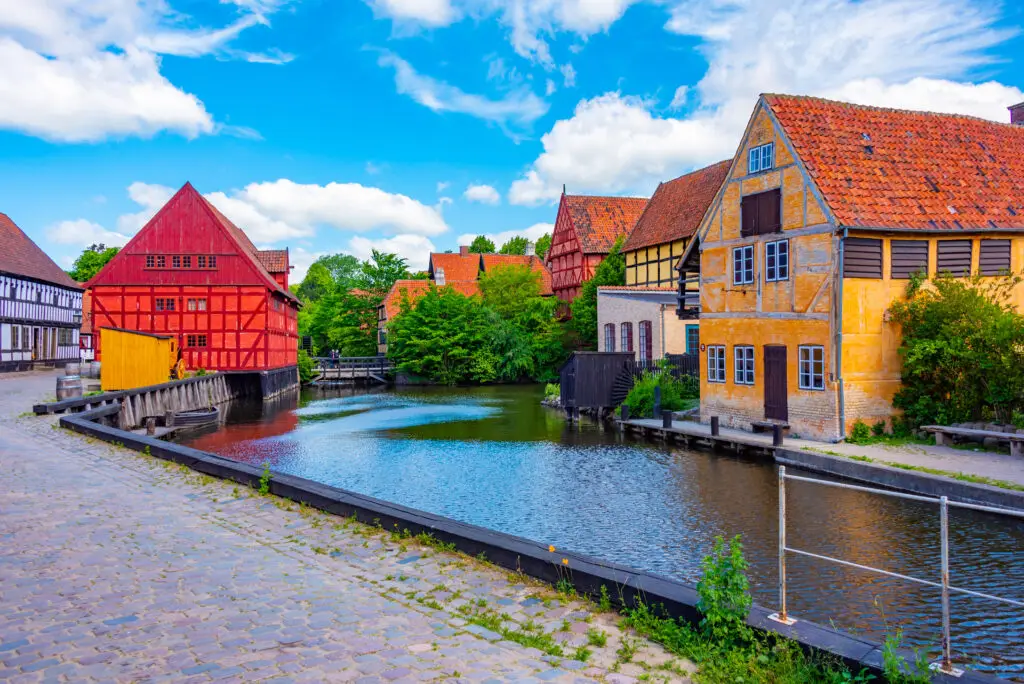
Cobblestone streets, timber-framed houses, and costumed townsfolk bring Danish history to life at Den Gamle By, Aarhus’s open-air museum.
With your guide, step into reconstructed city quarters from the 1600s to the 1970s, moving between merchant shops, 1970s apartments filled with vintage design, and living workshops where everyday life from the past unfolds before you.
The journey continues at Moesgaard Museum, a modern architectural landmark nestled into a forested hillside. Here, archaeology takes center stage—explore the Viking hall, meet the Grauballe Man, and interact with digital exhibits that connect ancient stories to the land beneath your feet.
The building itself invites exploration, with a rooftop meadow offering panoramic views over the surrounding landscape.
Later, drift into the quiet of Marselisborg Deer Park, a wooded reserve where fallow deer wander freely, and the only sounds are birdsong and the crunch of leaves. It’s a peaceful contrast to the immersive storytelling of earlier stops—and a chance to walk, observe, and breathe simply.
Day 23: Jelling Rune Stones & Viking Heritage Site | Skanderborg Lakes | Royal Mounds Visit
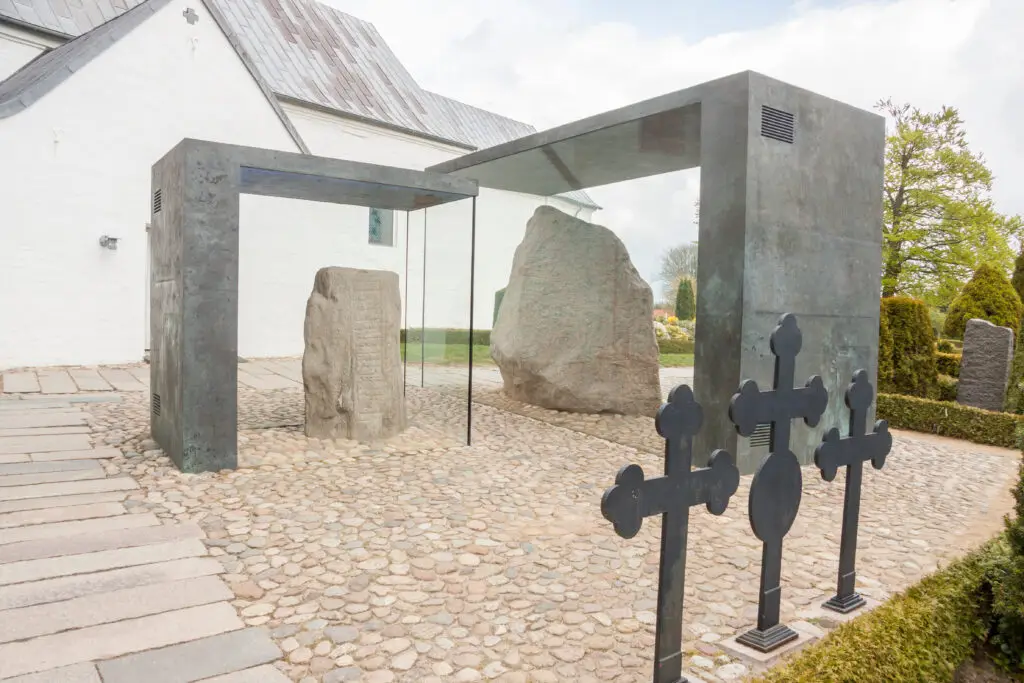
Travel into Denmark’s royal heartland to Jelling, home to the country’s “birth certificate”—the UNESCO-listed Jelling rune stones. These 10th-century monuments mark Denmark’s official Christianization and commemorate Viking king Harald Bluetooth.
Visit the Jelling National Museum and reconstructed palisade, walking the geometric layout that once defined this royal Viking stronghold.
Continue to the Skanderborg Lake District, a serene region of forests and glacial lakes. Take a short lakeside walk or stop at one of the viewpoints for photos and birdwatching. Your guide will share stories of Danish kings who used the area for royal retreats and how the region remains popular with locals for outdoor recreation.
End your day with a visit to one of the region’s royal barrows—burial mounds of ancient rulers set amidst rolling countryside. Your guide will explain burial customs, folklore, and the archaeological significance of these silent sentinels from Denmark’s prehistoric past.
Day 24: Silkeborg – Hike, Heritage & Lake Serenity
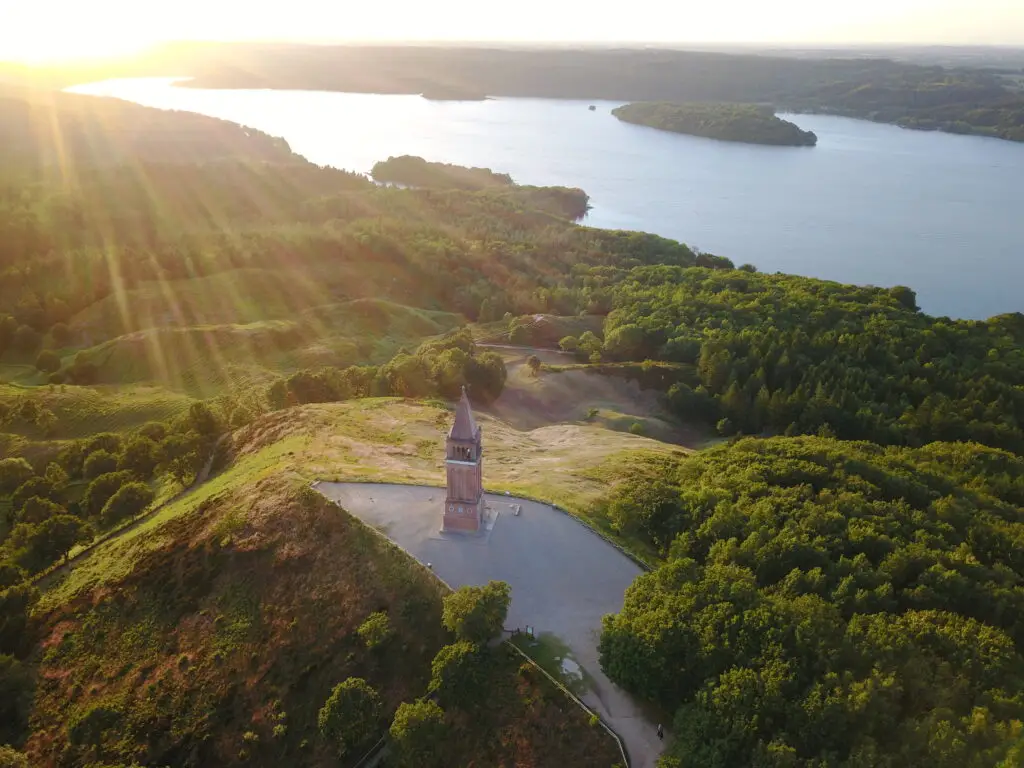
Begin your immersion in Denmark’s lakelands with a visit to Himmelbjerget, the famed “Sky Mountain.”
While not towering in height, its cultural significance and panoramic views over the Lake District are impressive. Follow forested trails with your nature guide, who’ll point out native flora, birdsong, and legends tied to this beloved Danish landmark.
Not far from the trails, step into the Silkeborg Paper Museum set within an old mill beside the river. Inside, explore the craft of papermaking through hands-on exhibits and historic machines that once powered both industry and wartime resistance. Stories of ingenuity and quiet heroism unfold in these restored brick halls.
In the afternoon, slow the pace aboard a vintage riverboat as it winds through the Silkeborg Lakes. The journey offers tranquil views of reed-lined shores and pine-covered hills while your guide shares stories of artists and writers who found lasting inspiration in these peaceful waterscapes.
Day 25: Aalborg – History, Architecture & Harbor Life
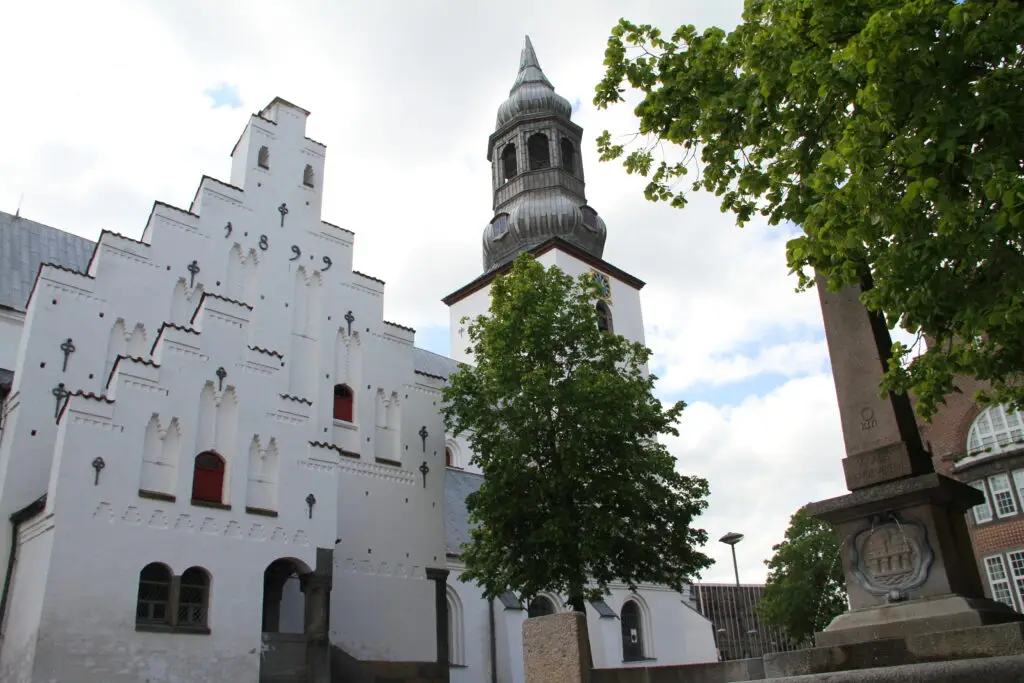
Travel north today to Aalborg, where past and present meet along cobbled streets and the Limfjord’s sparkling edge.
After settling in, set out on a guided stroll through the city’s old town—home to centuries-old merchant houses, colorful alleys, and landmarks like Budolfi Cathedral and Jens Bang’s House, each layered with tales of power, trade, and transformation.
Then, shift from old-world charm to cutting-edge architecture at the Utzon Center. With a private guide, delve into the legacy of Danish architect Jørn Utzon and his son Kim, whose sleek waterfront complex reimagines space as a “platform for life.” Light-filled galleries and thoughtful design invite conversation on how form and function shape our lives.
Later, take time to unwind. Whether enjoying the cafés and street art along the harbor promenade or soaking in the views from your boutique stay, Aalborg offers a relaxed yet creative energy to round out your day.
Day 26: Skagen Day Trip | Grenen Sandbar | Skagen Museum of Painters
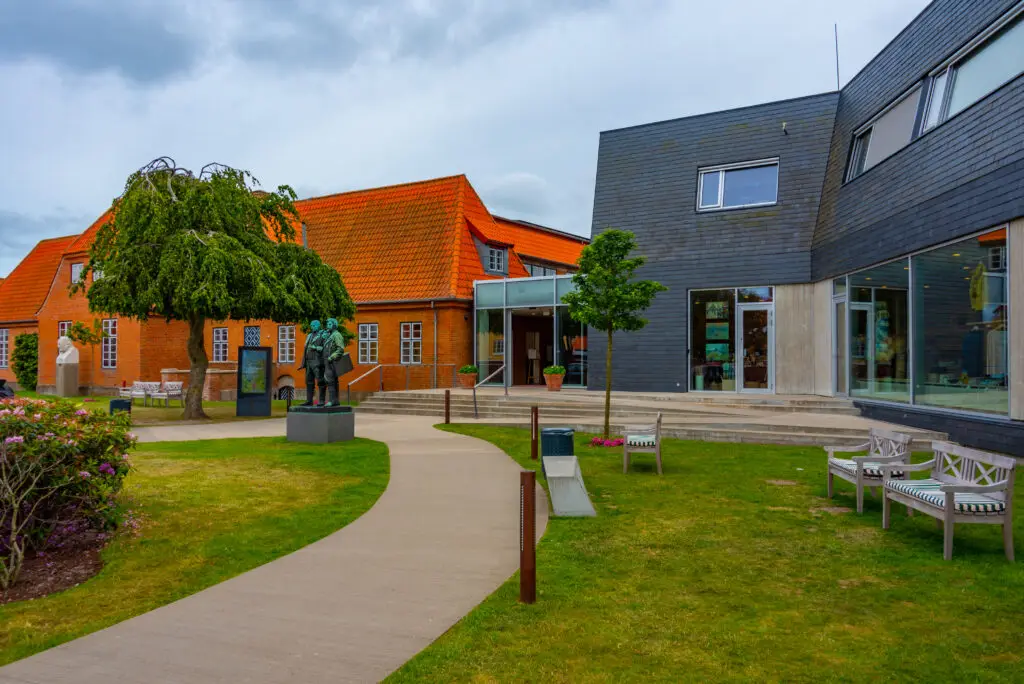
Set off with your guide for a full-day excursion to the tip of Denmark, where the Baltic and North Seas collide at Grenen.
On arrival in Skagen, begin with a beach tractor ride or guided walk to the very edge of Denmark’s landmass. Here, you can quite literally stand with one foot in each sea while your guide explains the unique currents and wildlife that make this area so ecologically significant.
Afterward, enjoy a private tour of the Skagen Museum, where the famous Skagen Painters—including Anna and Michael Ancher and P.S. Krøyer—captured the extraordinary light and life of the northern coast. Your guide, trained in art history, will discuss how this 19th-century artists’ colony shaped perceptions of Danish identity and landscape.
You’ll also visit the Anchers’ House or Drachmann’s Villa for further insight into their lives.
Conclude with a stroll through Skagen’s charming town center, lined with bright yellow houses, red-tiled roofs, and artisan shops, before returning to your base for the evening.
Day 27: Råbjerg Mile Moving Dune | Buried Church | Scenic Coastal Route
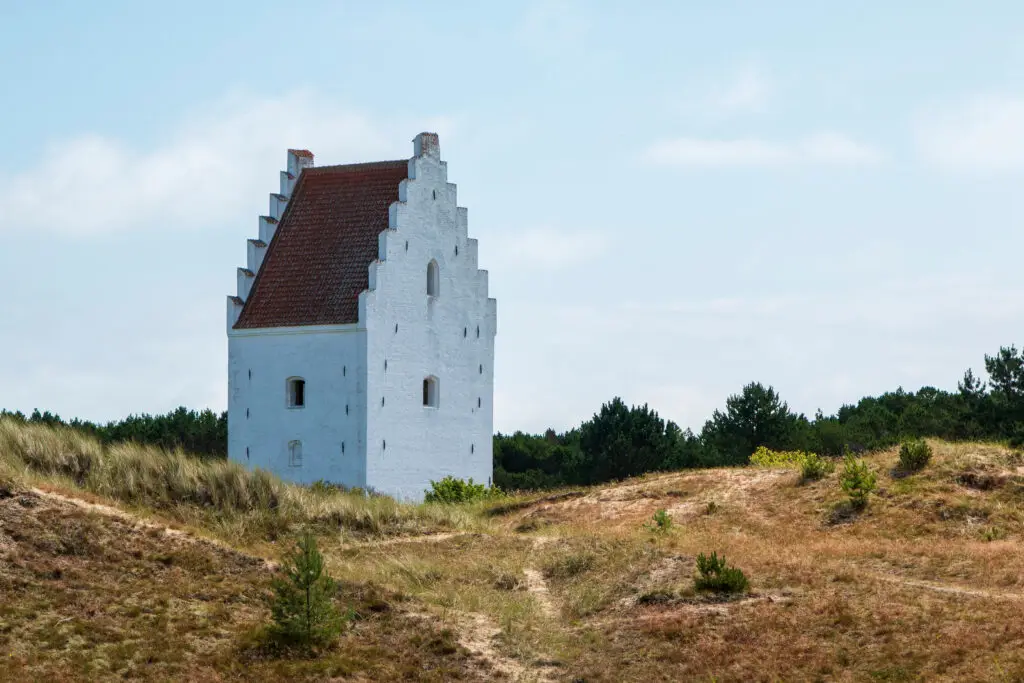
This morning, travel with your guide to the vast and shifting Råbjerg Mile, one of Europe’s largest migrating sand dunes.
Take a private guided walk through this Sahara-like landscape, where the dunes move up to 15 meters each year across heath and pine forests. Your guide will share the natural history and ecology of this unique environment, shaped by wind and sea.
Next, visit the hauntingly beautiful “Buried Church” (Den Tilsandede Kirke) just outside Skagen. Once a thriving parish, this 14th-century church was slowly consumed by drifting sand over the centuries. All that remains today is the tower, which rises starkly above the dunes.
In the afternoon, continue along the scenic west coast, pausing at viewpoints and coastal villages. Your route may include stops at beach bunkers, birdwatching points, or seaside cliffs, depending on your interests. The wind-sculpted landscapes and light here offer unforgettable photographic moments before you return to your accommodation.
Day 28: Rubjerg Knude Lighthouse Hike | North Sea Cliffs | Return Transfer to Aalborg or Copenhagen
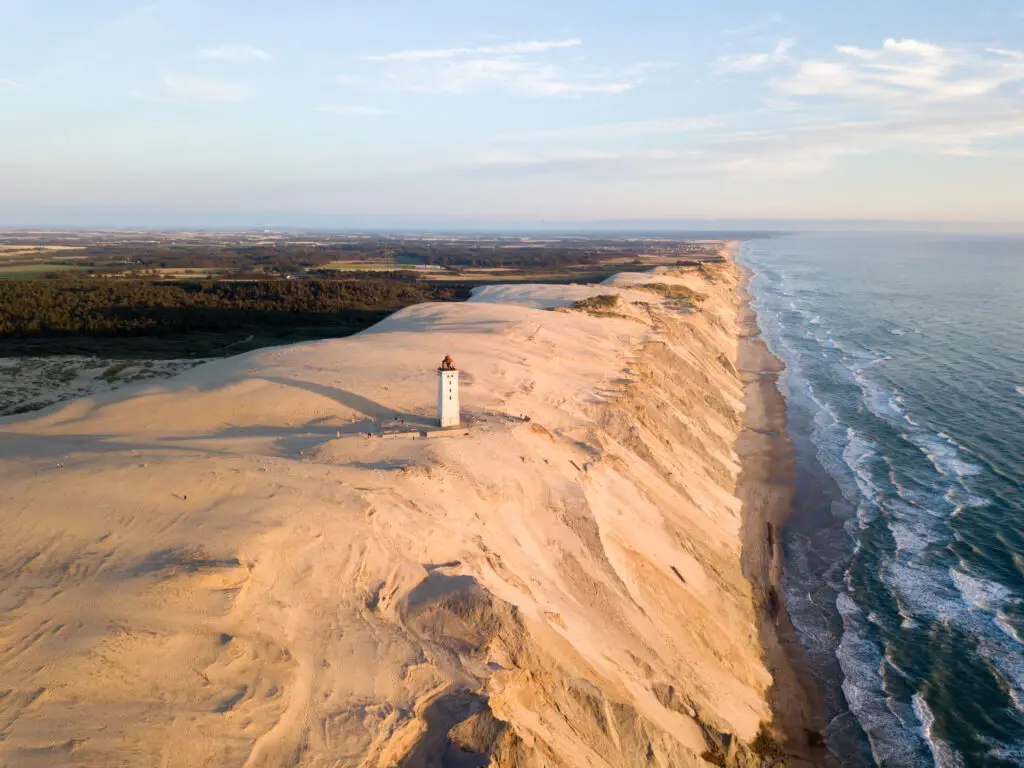
Your final day begins with a hike to one of Denmark’s most iconic coastal landmarks—Rubjerg Knude Lighthouse.
Perched atop a high dune overlooking the North Sea, the lighthouse was famously relocated in 2019 due to coastal erosion.
Weather permitting, walking the scenic clifftop path offers expansive views of the roaring sea and the endless horizon.
Next, continue along the coastal route for short walks and lookout stops, taking in Denmark’s rugged and lesser-seen landscapes. This area, rich in birdlife and shaped by storms, is a fitting final chapter to your nature-driven journey through Denmark.
Depending on your flight plans, your driver will transfer you to Aalborg Airport for your departure or begin the comfortable return journey to Copenhagen. Either way, your 28-day journey across Denmark’s coasts, castles, and countryside ends with lasting impressions of a nation deeply rooted in nature, heritage, and design.

